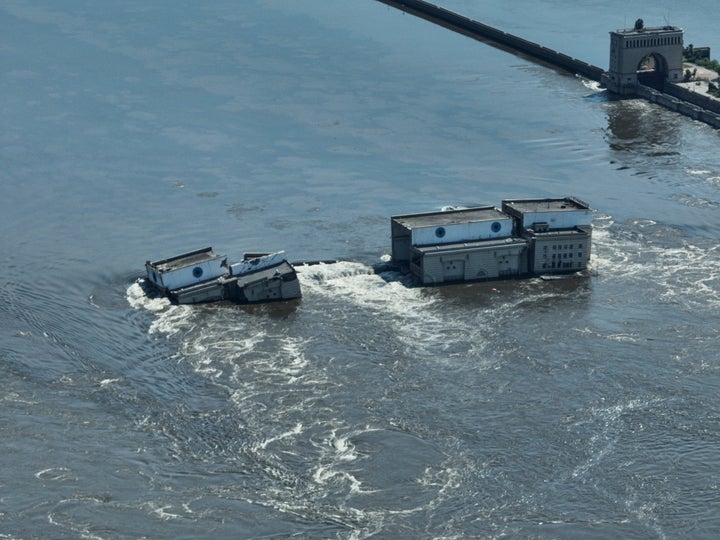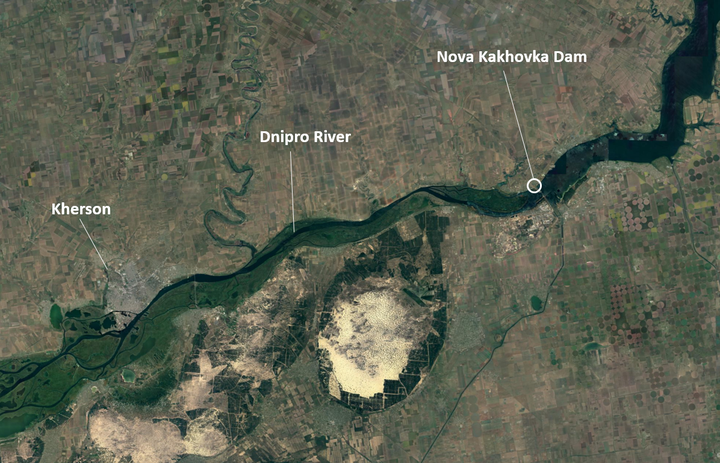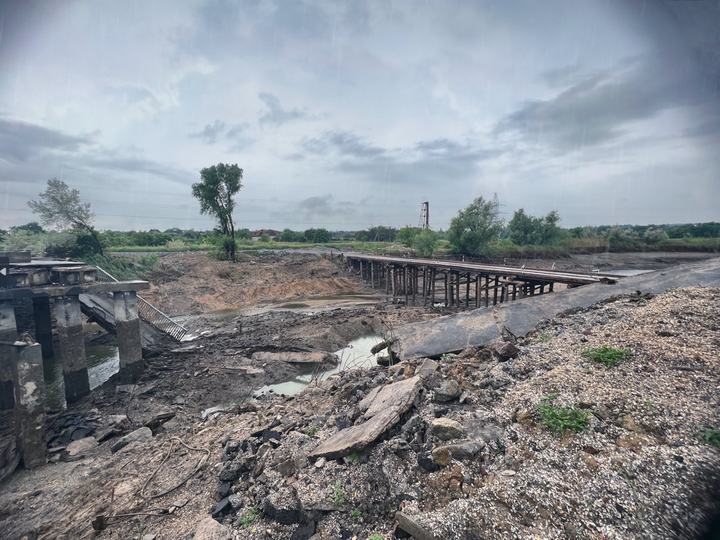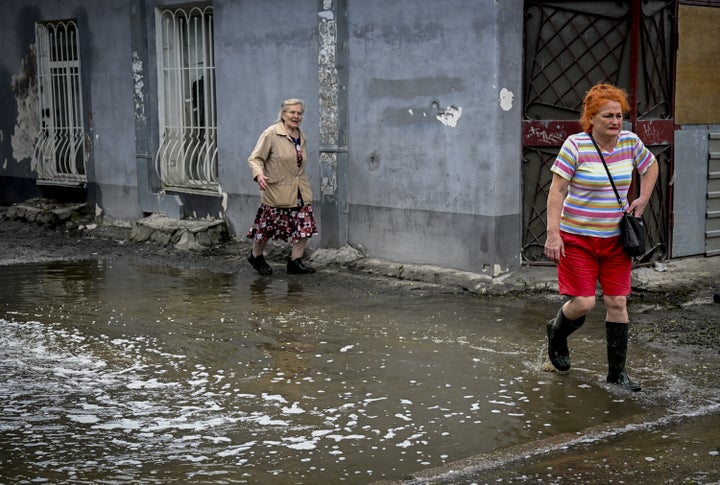
It’s “highly likely” Russia was responsible for the destruction of a critical Ukrainian dam, according to an international human rights law firm.
Global Rights Compliance, a not-for-profit, investigated the collapse of the Kakhovka Dam which caused significant localised flooding, and a humanitarian and environmental crises on June 6.
It joined forces with Ukraine’s office of the prosecutor general as well as a team of military experts and open source intelligence specialists, for its investigation into the disaster.
It has since concluded that Russia was probably behind the devastating collapse of the dam, and its accompanying hydroelectric power station.
In its initial report, released on Friday, the human rights lawyers concluded that there is a “high probability the collapse of the dam was caused by pre-emplaced explosives positioned at critical points within the dam’s structure”.
Here’s what you need to know.
What happened to the dam?
A critical (and enormous) dam in Ukraine’s Dnipro river appeared to collapse very early on June 6, at a time when the water levels were at a particularly high level.
The Kakhovska dam and hydroelectric power plant, which dates back to the Soviet era, both sit in the city of Nova Kakhovka.
That’s in southern Kherson, a region which has been under Russian control since the early stages of the war. It was annexed illegally back In September.
On June 6, the power plant’s operator confirmed that “as a result of blasts in the machine hall, the Kakhvoka hydroelectric power station is completely destroyed. It is not recoverable”.
The river levels in the meantime climbed by around 15cm an hour, affecting people in both Ukrainian land and the Russian occupied areas.
Landmines washed away by the flood of the dam are also now a continuous threat to the community.

It is said to be the worst environmental disaster in the country since the nuclear accident at Chernobyl in 1986, because the destruction of this dam will have long-term knock-on consequences for local people’s water supply and possibly global food supplies.
The dam was used to cool down a crucial nuclear power facility upstream, in Zaporizhzhia, and to provide drinking water in Crimea. Both of these areas are mostly occupied by Russians at the moment, but will now be affected by the disaster.
According to Global Rights Alliance’s investigators, the dam’s collapse will also disrupt irrigation systems for more than half a million hectares of nearby land, have a generational impact on the local natural environment and the region’s agricultural capacity, while leaving hundreds of thousands of Ukrainians left without drinking water.
But, it was not immediately clear who was to blame, as both sides pointed the finger at the other.
Yousuf Syed Khan, the senior lawyer supporting the investigation said what he saw in Kherson is a “horrific starvation crime”, which will have “immense, far-reaching” effects and last for generations.
He added: “The devastation wrought by this disaster cannot be overstated and will undoubtedly be felt for years to come as entire industries, from irrigation to agriculture, water, fishing, livestock, and several more, now face the widespread, long-term, and severe impacts.”
Why do investigators think Russia is responsible?

The Starvation Mobile Justice Team is part of the Atrocity Crimes Advisory Group, sponsored by the UK, EU and US government.
The team supports Ukraine’s Office of the prosecutor General looking into Russian starvation war crimes, and claims to be among the first investigative units, prosecutors and military experts to visit the affected areas in Kherson and Myokolaiv Oblasts after the disaster in early June.
It looked at the surrounding site with regional prosecutors, representatives from the international criminal court and Ukraine’s office of the prosecutor general, before concluding that the collapse was likely caused by “pre-emplaced explosives positioned at critical points within the dam’s structure”.
The dam has been occupied by Russian forces for months – and investigators think the attack was probably orchestrated from those managing the dam.
Dismissing theories that the dam may have collapsed due to mismanagement, the investigators also claimed: “It is highly unlikely that mismanagement alone would explain such catastrophic destruction.”
Why do investigators think there was a ‘smoking gun’?
One key part of the team’s evidence comes back a new Russian law which stops any investigations into accidents at hydro-technical structures in Russian occupied Ukraine.
The law states that until January 1, 2028, any such accidents, caused by military operations, sabotage, and terrorist activities, cannot be examined.
That law change was introduced just a week before the dam’s collapse – which is why the team believe they have “something of a ‘smoking gun’”.
The investigators also claimed they had evidence showing Russians preventing Ukrainian evacuations from flooded areas, while also shelling the evacuation points.

What does this mean – is it a war crime?
The UK’s foreign secretary James Cleverly called the dam’s destruction a “war crime” shortly after the incident, although he stopped short of saying who was guilty of such a crime.
Now, UK barrister and starvation expert Catriona Murdoch, who led the Global Rights Compliance’s investigation, said the attack speaks to “a calculated plan to starve, terrorise and force the capitulation of Ukrainian people, no matter the cost”.
She also said it was part of an “ongoing pattern to deliberately starve civilians and punish the Ukrainian people”, where Russia seems to repeatedly attack water infrastructure and other civilian areas.
Murdoch concluded: “It therefore falls squarely under international humanitarian law, binding on all parties to the conflict in Ukraine.”
Dams are presumed to be civilian in nature in international humanitarian law, so unless there is a valid military objective, an attack on one can be seen as a war crime.
Even then, according to the lawyer, because the dam is “indispensable to survival by virtue of its utility as a hydro-energy source”, any attack on it is questionable.
She continued: “Dams may not be attacked when the release of water would lead to severe losses among the civilian population. Even valid military objectives situated on or near dams cannot be attacked if the impact would knowingly cause severe losses among the civilian population.
“What is also clear at this stage is there was a wholesale failure to effectively warn civilians and minimise the severe losses they endured. Civilians living near the Kakhovka Dam were not warned of an impending attack and were even shelled as they attempted to evacuate flooded areas.”

